In this guide, you’ll learn what eCommerce marketing is and the most important eCommerce Marketing strategies.
What is eCommerce Marketing?
Ecommerce marketing uses digital strategies to drive traffic to your online store, convert visitors into customers, and retain them for repeat purchases. It involves a mix of tactics, including SEO, social media marketing, email campaigns, paid advertising, and content marketing, all designed to increase brand awareness and boost sales.
Why is eCommerce Marketing Important?
eCommerce marketing is important because it gets your business in front of your target audience while bringing traffic to your website. Without marketing, the people who are interested in the kind of products that you sell would have no way to discover them.
eCommerce marketing helps people find your business while establishing a clear and unique brand identity.
As people become familiar with your brand, eCommerce marketing conveys the value of your products before eventually convincing them to become customers.
But it doesn’t end after someone makes their first order. eCommerce marketing nurtures the relationship to provide a great post-purchase experience. By doing so, it creates customer loyalty and happy repeat buyers.
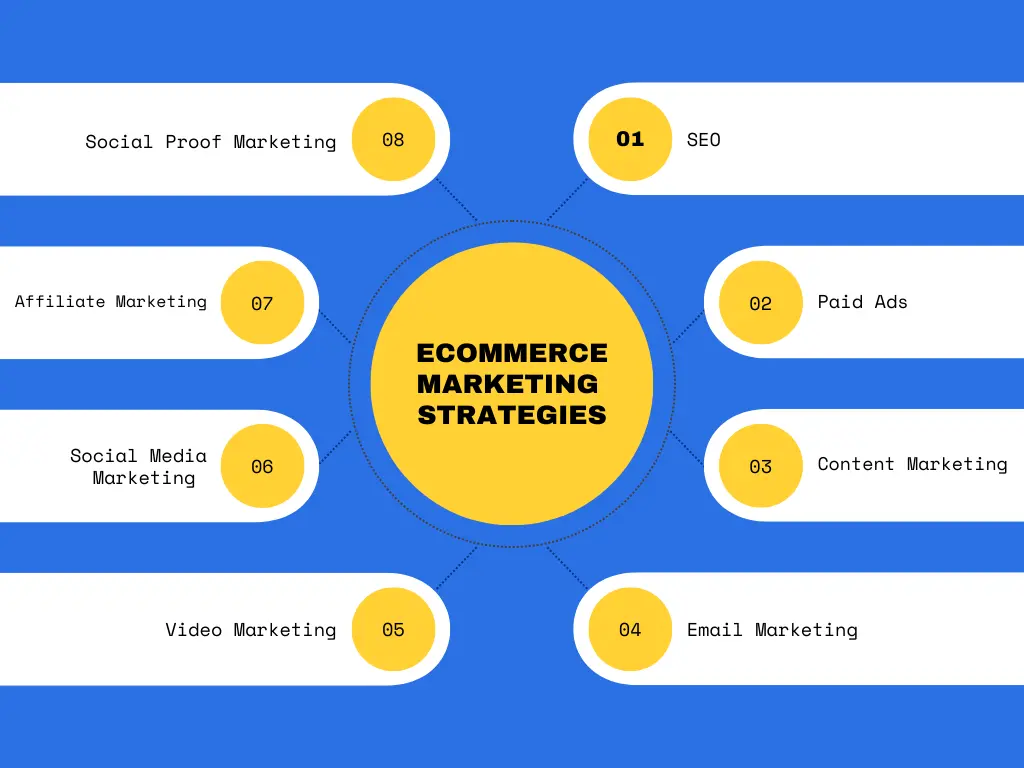
eCommerce Marketing Strategies To Increase Sales
The most effective eCommerce marketing strategies to increase sales of your eCommerce store are:
1. Search Engine Optimization (SEO)
Search engine optimization (SEO) is a marketing strategy for getting your website and products to the top of search results for platforms like Google.
Search engines are one of the most common ways people look for new products, so getting your store to the top of the results can lead to many visitors and customers for your site.
To optimize your eCommerce site for SEO, follow these steps:
Step 1: Perform Keyword Research
The first step in eCommerce SEO is keyword research. Knowing the precise keywords that your customers are using will help you optimize your website accordingly.
When looking for good keywords to target, it’s important to consider competition and keyword search volume.
The more generic terms with the highest search volume often have the strongest competition. For instance, a keyword like “shoes”.
You may sell shoes, making it a relevant keyword, but it will be difficult to outrank major businesses like Nike, Amazon, and Nordstrom.
Long-tail keywords, such as "men’s running shoes black size 10," are an effective way to still target relevant keywords.
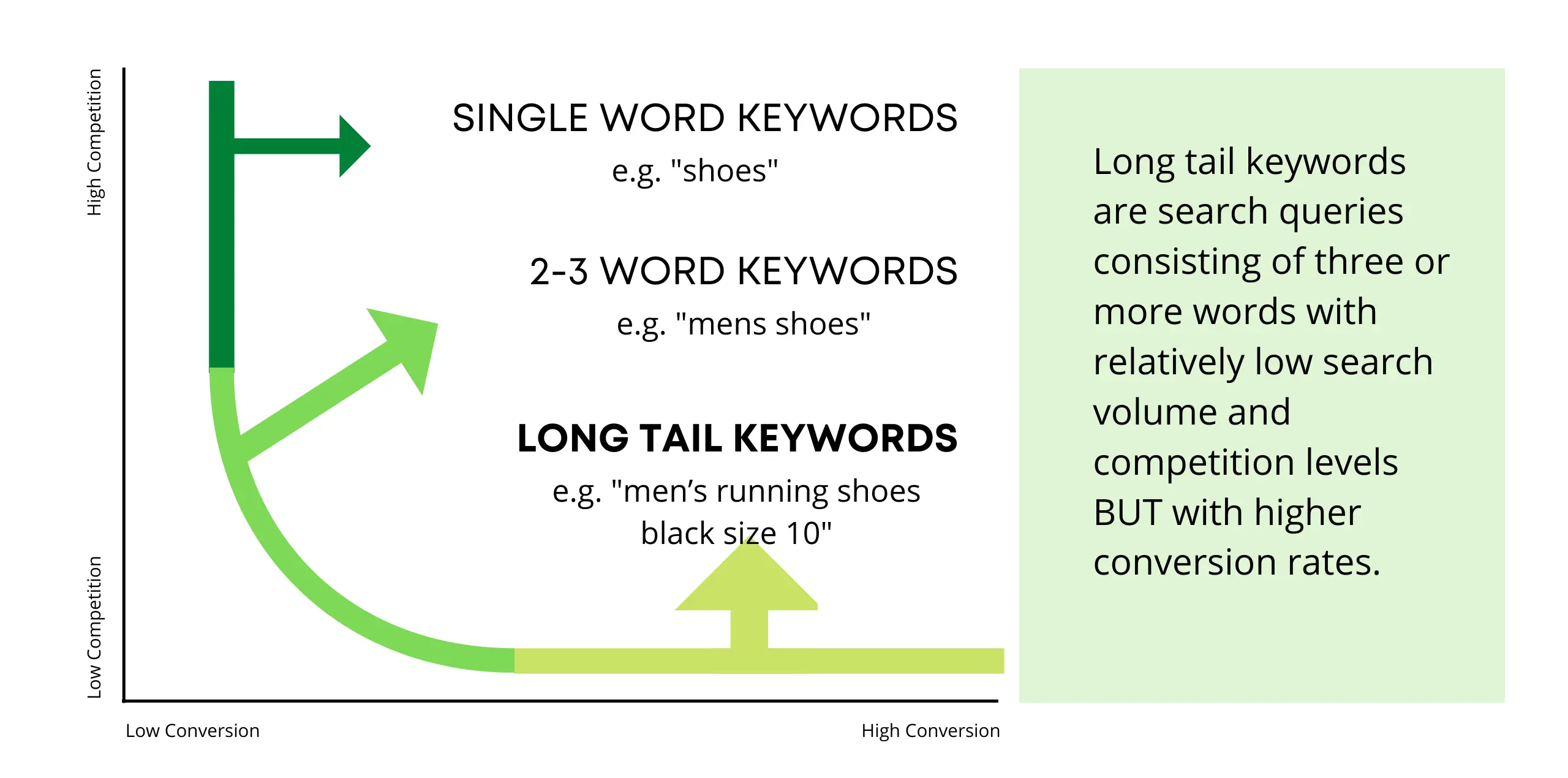
These terms are very specific and generally less competitive. They also indicate a higher intent, meaning the searcher is more likely to purchase after clicking through to your site.
Once you have your target keywords, you need to incorporate them into your site. Several important SEO elements must also be optimized.
Step 2: Add alt text to all images
Alt text is an HTML text tag applied to images. They give a short, written description of what the image is about. These tags help search engines understand your images and site, making them an important SEO factor.
eCommerce sites have a lot of images. You’ll need to add the most relevant keywords to each product image and banner on your site.
Step 3: Work on improving your page speed
A fast website is essential to your store’s ability to rank for your target keywords. Slow pages lead to poor user experiences, so Google punishes them with low rankings.
Ensuring your pages load quickly will improve search performance and increase visitor engagement and sales.
Read this guide on how to improve your page speed for more information.
Step 4: Optimize your site architecture
Site architecture (the hierarchical structure of your website pages) is an important SEO factor as it helps search engines and users find information and understand your site.
You want to ensure your products are segmented into clearly organized categories for an eCommerce site. Your homepage should link to all major category pages, and no page should be more than three clicks from any other page.
2. Paid Advertising
Paid advertisements are a key part of any eCommerce marketing strategy.
Through advertising, you can get your business and products in front of your target audience at every stage of the buyer’s journey.
Let’s look at some of the most effective ads for eCommerce stores.
Google Shopping Ads
Google Shopping Ads allow you to showcase your products at the top of Google Shopping results. These ads can also appear at the top of Google Search results for specific queries.
Similar to organic Shopping listings, you need to set up a product feed in Google Merchant Center to run Shopping ad campaigns.
Your Google Ads account will connect to your Merchant Center account to get your products. From there, you can start building your campaigns.
Unlike Search campaigns, you don’t select the keywords to target. Instead, Google will determine when to show your ads based on your product details and the information on your site.
While there is no keyword targeting, there are still negative keywords. These are a list of specific terms for which you don’t want your products to show up.
As an eCommerce store, adding negative keywords for broader terms and keywords with lower transactional intent, like “shoes” or “t-shirt,” is often helpful.
These searches are less likely to be ready to buy. You can optimize your ad spend by focusing on more specific terms or with higher transactional intent.
Facebook Product ads
Facebook Product Ads lets you showcase single or multiple products to Facebook and Instagram users.
You can target specific audiences based on their interests or show ads to users who previously engaged with your site.
For example, you can set up a Dynamic Products Ads campaign to show users different items from a category they previously visited.
You need to install the Facebook Pixel on your site to use dynamic ads. Like with Google, you must also upload your product catalog to Facebook’s Commerce Manager. This is a straightforward process, as all the top eCommerce platforms offer seamless integration to push items from your site to Facebook.
YouTube Action campaigns
Action campaigns are in-stream and in-feed ads that appear during YouTube videos.
These ads are designed to maximize conversions. You can add headlines, descriptions, and a “call to action” to accompany the videos.
YouTube Action campaigns are easy to manage and can help you reach your audience at scale. In addition to appearing on YouTube, they can also appear on Google partner sites.
3. Content Marketing
Content marketing is the process of creating content, such as blog posts and infographics, and then sharing that content with your target audience.
With content, potential buyers will become aware of your brand, and frequent readers will build strong relationships with your business. When they go to complete a purchase, they will be more likely to consider your brand.
Content marketing has the added advantage of boosting your SEO efforts, as you can use your content to target and rank for various keywords.
So, what types of content should you create?
One approach is to write blog posts related to the products that you sell. For instance, if you sell automotive tools, you can write blog posts about “how to change brake pads”.
Below is an example of this with the pet toy subscription service BarkBox. They use a post about how to wash dog toys to target people interested in the subject.
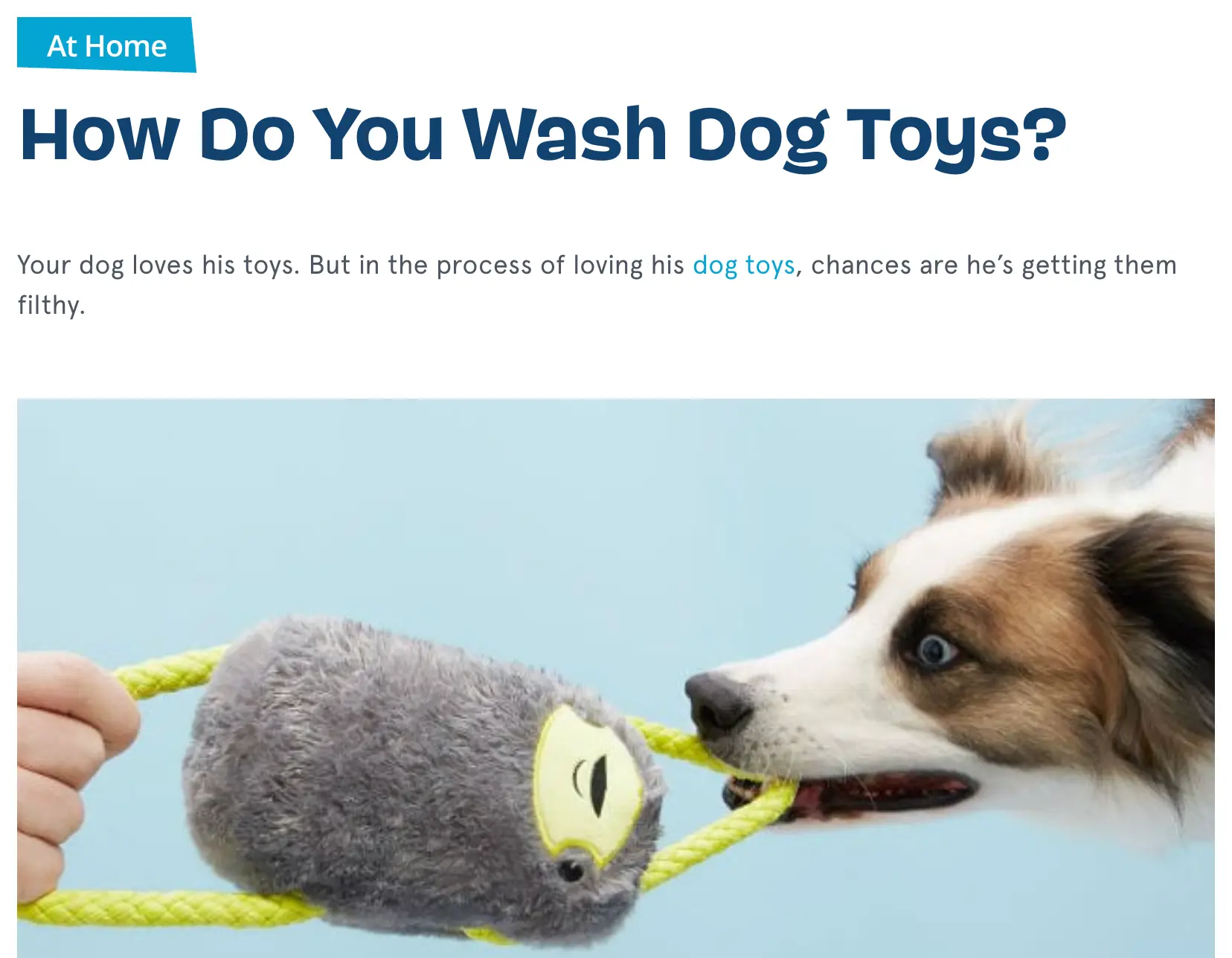
In the post, they also reference and link to several of their products.
You can also blog about terms with more commercial intent. For instance “best brake pads for Toyota Corolla”.
With these terms, you can create product reviews comparing some of the best options in your store.
Another eCommerce content marketing strategy is to guest post on other sites. This allows you to reach more potential customers by tapping into the other publisher’s audience.
People who read your guest posts will learn about your business, and many will click through to your site.
4. Email Marketing
Email marketing is a well-established form of digital marketing and an effective tool for eCommerce companies.
It works well because it enables you to get messages directly in front of customers. Many people pay more attention to the messages in their inbox than the ads they see across the web.
Because of this, email is great for communication, relationship-building, and driving sales.
Another great thing about email marketing is that it can be automated. Once you get your campaigns up and running, automatic messages will go out to the people specified in the campaign.
Here are some of the best kinds of emails to send to your customers and subscribers:
Abandoned cart emails
An abandoned cart occurs when someone leaves your website with an item(s) still in their shopping cart.
Cart abandonments are incredibly common in eCommerce and an inevitable part of doing business. While you can take steps to mitigate your number of cart abandonments, some shoppers will always leave with products in their carts.
Abandoned cart emails let you remarket to these people by email, reminding them to return and complete their purchase.
You can make these messages highly targeted by including the exact products the person was in the process of buying.
Many eCommerce brands look to incentivize potential buyers by including discounts and promotional offers in their abandoned cart emails.
With eCommerce platforms and email marketing services, you can get an abandoned cart campaign up and running quickly. These platforms can track your shopping sessions to determine when someone exits the site with a filled cart.
If you have this person’s email address, you will add them as recipients for the email campaign.
You can control the timing of the messages to maximize their effectiveness. For example, you can send a follow-up message a few minutes after the person leaves or a few hours later.
Cross-sell and upsell emails
Cross-sell emails suggest product recommendations based on what the recipient has browsed or purchased in the past.
For example, you can create a cross-selling campaign showcasing yoga mats to an audience that has previously purchased yoga leggings.
Cross-sell emails can increase your average customer lifetime value by turning people into repeat buyers.
Another way to increase your revenue is to send upsell emails. These emails target people who have browsed or bought from your store and encourage them to increase their spending.
These can be in the form of recommending more expensive products or promoting post-purchase add-ons and accessories.
Transactional emails
Transactional emails are messages that are triggered by a specific action in the purchase process. The most common transactional emails are order confirmations, shipping confirmations, and post-purchase follow-ups.
Unlike other email messages, transactional emails are one-to-one emails instead of mass emails sent to an audience.
While these messages are transactional in nature, they also make great real estate marketing messages. Customers open and read these messages more than any other, so adding a promotion or showcasing some of your products can see positive results.
5. Video Marketing
eCommerce video marketing is a marketing strategy where you use different forms of videos to promote your brand and products.
Videos are great at capturing attention and are often better at conveying information than text or images.
Naturally, YouTube is the best platform for reaching your audience via video. With over 2.5 billion active users, the site is the second-biggest search engine behind Google.
You can create a YouTube channel to publish videos highlighting your products. YouTube is also a great place for tutorials and explainers that teach how to use your products.
Product reviews also work well in video format. Many consumers go to YouTube to learn about and compare products. By creating product reviews, you can be in front of potential buyers and direct them back to your site.
YouTube ads
YouTube Ads are another great way to use video in your eCommerce marketing.
We’ve already discussed the benefits of Action campaigns, but several other ad formats are also available.
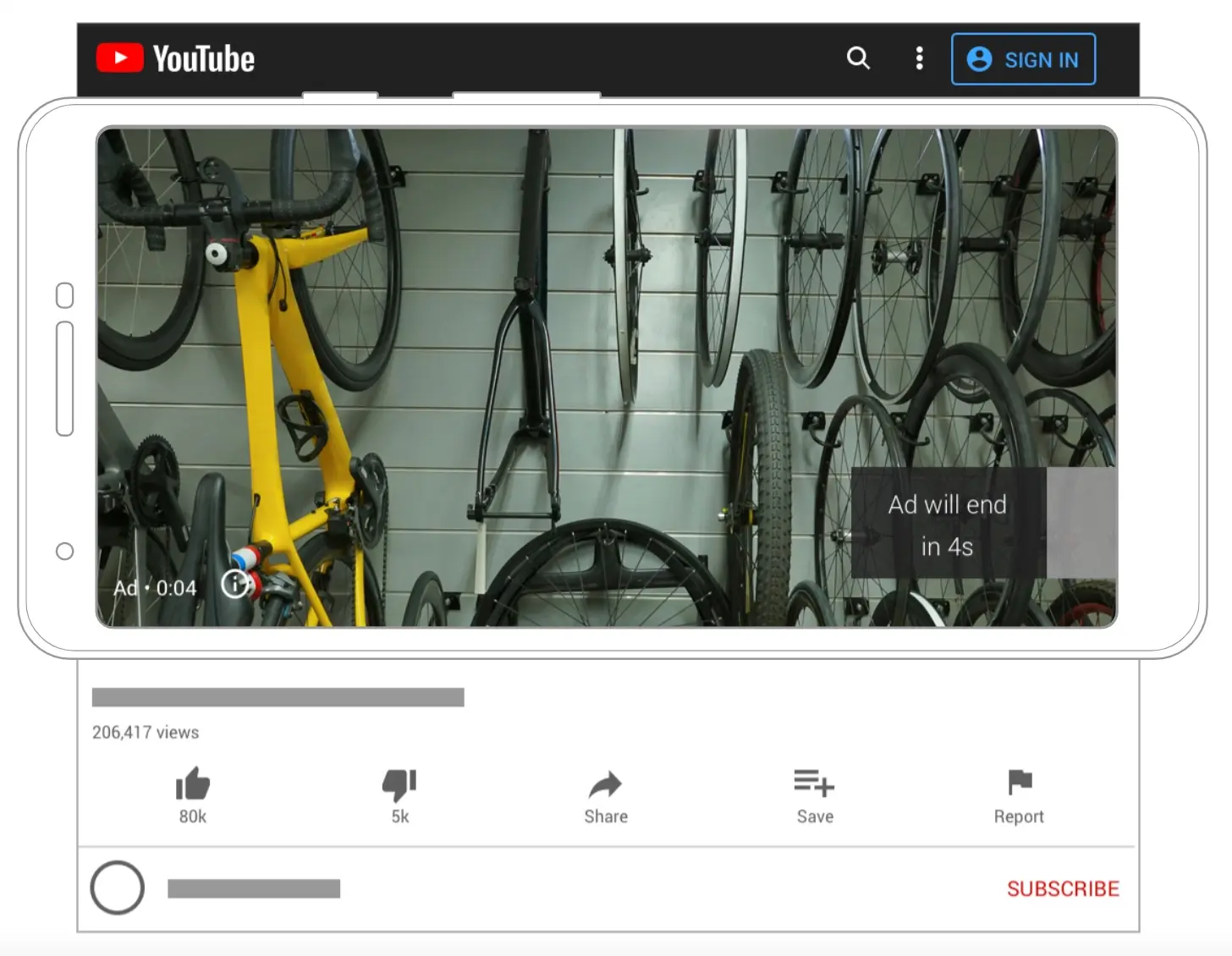
As an eCommerce seller, your video ads must immediately highlight your product’s main benefits. You want to capture customers’ attention quickly. Plus, some ad formats are short-from, so you only have a few seconds to work with.
6. Social Media Marketing
Social media networks are an integral part of an eCommerce marketing strategy.
Popular platforms have huge audiences; many users use the platform to research brands and products.
While most platforms work well for eCommerce marketing, the best platforms to focus on will depend on your business and it's unique needs.
Instagram is great for brands to establish their identity and grow awareness through visual mediums.
Facebook and Instagram are great for social commerce; customers can buy products directly from your profile.
Facebook is also great for engaging with your audience and providing customer service. People can contact you through the Messenger app, making it easy to answer their questions.
Here are some tips for using social media for eCommerce marketing:
Post regularly
To grow your social media presence, you need your audience to keep you at the top of your mind. You can achieve this by regularly posting content to your preferred channels.
The ideal posting frequency will depend on the platform. For visual platforms like Instagram and TikTok, it’s best to post at least every few days.
If you have enough content to post every day, you can keep your audience really engaged.
Connect with influencers
Influencers have a massive presence on social media, and they are one of the best ways to market your business. People trust the recommendations of the influencers they follow, and many will flock to your products if they discover them from an influencer.
eCommerce brands can connect with influencers through sponsored endorsements. The influencer will share your products for compensation, and you will enjoy the benefits of sales and increased brand awareness.
Run contests
Contests are great for engaging and giving back to your audience. Everyone loves winning prizes, so contests generally have strong responses.
A common social media content is the “like and share” contest. You instruct users to follow your page and like a specific post to be entered into the giveaway.
Another effective technique is the photo contest. With this, you ask users to upload a certain type of picture and tag your business.
Get user-generated content
User-generated content is content created by followers that includes your brand.
The most common form of user-generated content is posts with images of the customer and your product. Brands can add hashtags so others can follow the trend and participate.
User-generated content can be highly effective in winning sales. You let the customers do the marketing for you.
7. Affiliate Marketing
With eCommerce affiliate marketing, other people and companies promote your products for you. When they lead to a sale, they earn a commission.
Affiliate marketing can be very profitable for eCommerce companies. You can leverage the efforts of others to reach your audience, and you don’t have to pay affiliates until after they’ve brought you sales revenue.
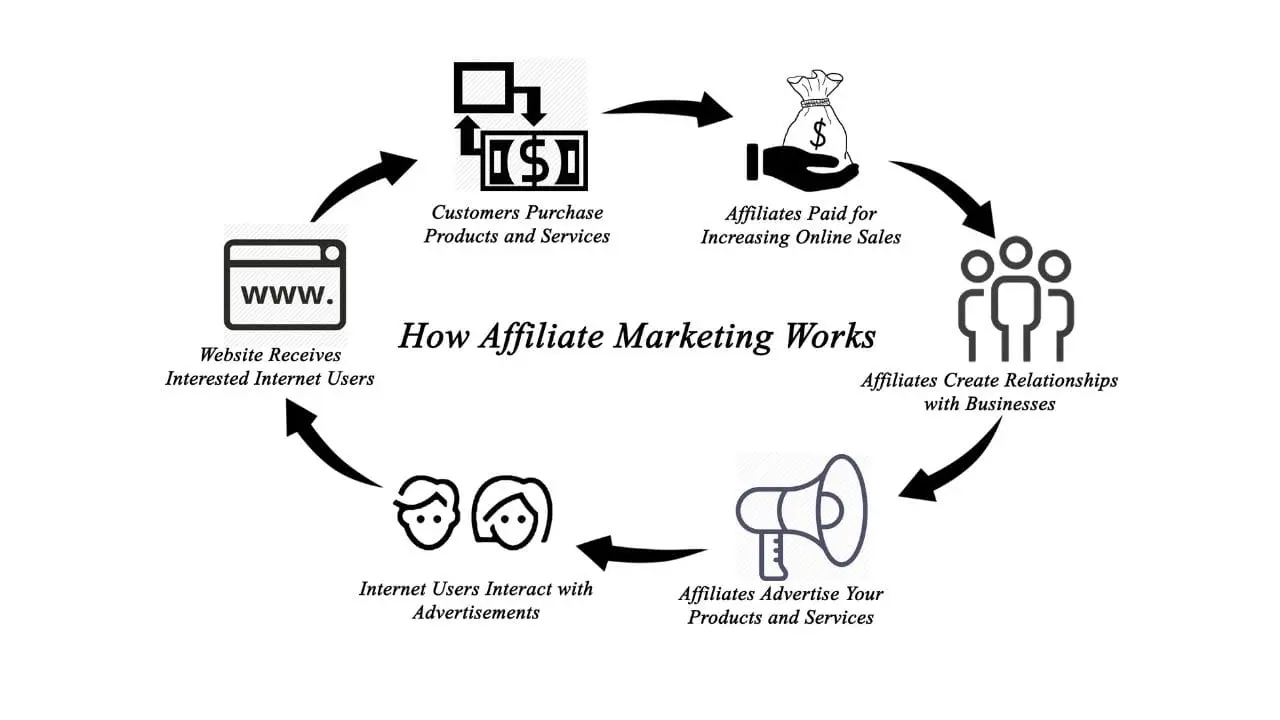
Affiliates also have their own established audiences, allowing you to get your brand in front of even more people.
The key to a successful affiliate program is high-quality affiliates. To attract the best possible partners, you want to create a solid commission structure. A high-paying affiliate program will make promoting your products worth it to the affiliate.
E-commerce product affiliate commission rates typically range between 5% and 15%. The amount you’ll want to offer will depend on your industry and product margins. You can also consider the value of the affiliate.
If someone is bringing in a lot of sales, it can beneficial to reward them with better commission or other exclusive offers.
Here are some other ways to improve your eCommerce affiliate program:
Connect with your affiliates regularly
Regular communication can lead to better affiliate marketing results. You want affiliates to be on top of your business's latest product launches and other happenings. Doing so will ensure they have everything they need for success.
Create banners and visual assets
Marketing visuals are key to successful campaigns. However, they can be tricky to create, especially if you’re trying to adhere to specific branding.
You want to remove this requirement from your affiliates by creating effective banner ads. They can use these branded visuals to market your business.
8. Social Proof Marketing
Social proof is the idea that people unsure how to act will often look to others for clues to help them decide.
For eCommerce, social proof comes in some form of positive feedback or recommendation from individuals in your audience.
People trust the recommendations of their peers above all else, making social proof one of the best forms of eCommerce marketing.
The most common type of social proof is product reviews. Today, pretty much every shopper references an item’s rating and reviews before buying it. This happens whether people are shopping on a marketplace like Amazon or on your own direct-to-consumer site.
Many consumers also check feedback on third-party review sites like TrustPilot. Getting positive reviews on these sites can boost your business’ credibility.
While customers like to read reviews, it’s not a natural reflex for them to provide them. If you want customer feedback, you must encourage buyers to leave a review.
The best way is often to simply ask for it. If someone likes your product and has a positive buying experience, they can show appreciation by leaving a review.
However, for some, the effort of leaving a review can discourage them from doing so. To encourage these people, add an incentive. This could be a discount or a free product.
9. E-commerce Analytics
Monitoring your performance is the key to success with any eCommerce marketing strategy.
You need to know what is working and what is not. This will help you determine where to increase your focus and where to make adjustments.
Key performance indicators (KPIs) are the metrics used to track and measure the success of your eCommerce marketing.
Below, we’ll look at the most important KPIs to track for eCommerce:
Conversion rate
The conversion rate is the percentage of total users who perform a specific action on your site. This action could be placing an order or signing up for an email newsletter.
Here’s how to calculate the conversion rate. Let’s say, you have 100 visitors and five of them make orders, then you’ll have a 5% conversion rate.
Conversion rate is one of the most important eCommerce metrics because it clearly indicates how well you turn visitors into customers.
Increasing your conversion rate also boosts almost every other eCommerce KPI.
Average order value
The average order value is the average amount your customers spend per transaction. It’s an important KPI to track because it shows how well you can sell multiple products and execute cross-sell and upsell initiatives.
Customer lifetime value
Customer lifetime value (CLTV) measures the average amount your buyers will spend over their lifetime.
This metric is important because it shows how well you can retain customers and drive repeat purchases.
Cart abandonment rate
Your abandon cart rate measures the percentage of people who abandon their carts after adding a product.
High abandon cart rates indicate that there is friction somewhere in the buying process. Lowering your cart abandonment rates is key to maximizing conversions.
Gross merchandise volume
Gross merchandise volume (GMV) is the total value of the product that you sell over a period of time. GMV is important for the obvious reason of it shows how much sales revenue you are bringing in.
Return on ad spend
Return on ad spend (ROAS) measures how much revenue you generate for each dollar spent on advertising. For example, if you spend $5,000 on a campaign that brings in $20,000, your ROAS is (400%). This means every dollar spend brought four dollars back.
ROAS is important because shows how effective your advertising campaigns are.
Customer acquisition cost
Customer acquisition cost (CAC) is the average amount you need to spend to acquire a new customer. For example, if you spend $1,000 on marketing and acquire 100 new customers, your CAC is $10.
CAC is critical as it gives insight into your overall profitability.
It is also one of the most important KPIs to measure in the early stages of your business. During this period, you’ll rely more on paid marketing to drive sales.
How to Learn eCommerce Marketing?
Here are some additional resources to help you learn eCommerce marketing.
- How to become an eCommerce Specialist
- How to Learn eCommerce Online (Beginners Guide)
- WooCommerce SEO Tutorial For Beginners
Conclusion
Great marketing is an essential part of an eCommerce business. By implementing the strategies we covered, your business can reach your audience to engage, grow awareness, and sell more products.



